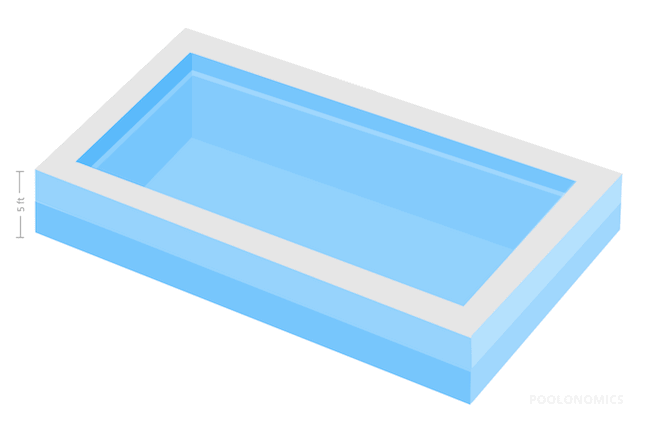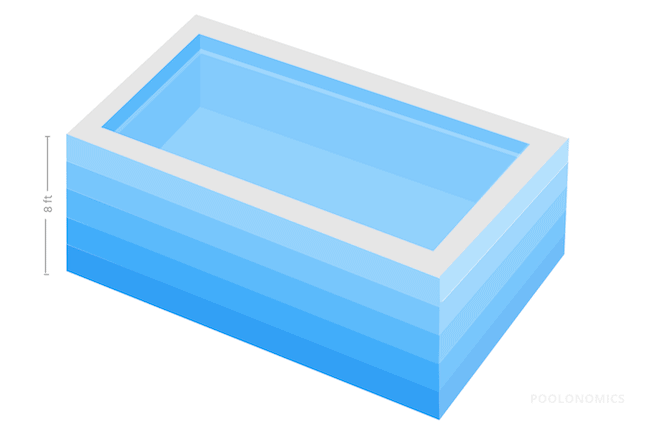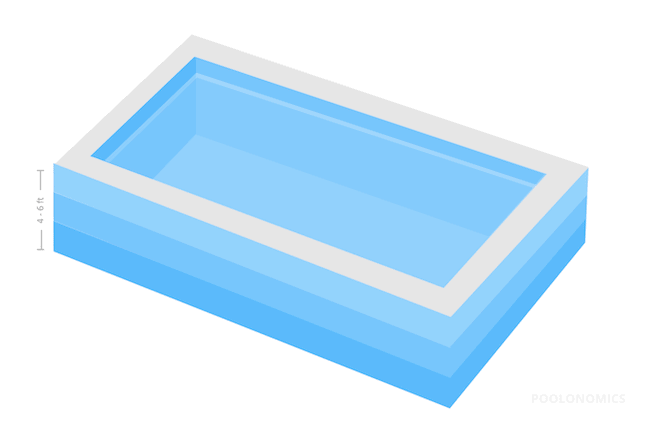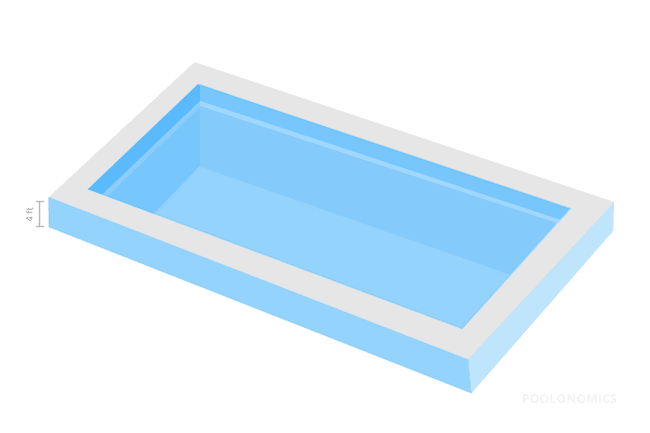Swimming pools come in all sorts of shapes and sizes.
One of the nice things about today’s pools is that they’re highly customizable, right down to the floor – literally!
It used to be that a pool’s depth was set in stone, but modern pools allow you to build them as deep or shallow as you’d like.
How Deep Is The Average Pool?
The average depth for the deep end of a residential inground pool is 8 ft.
For safety reasons, this is the minimum depth a swimming pool must be at if you’re going to be diving into it.
Pools that are designed with diving boards also need to be bigger than a pool without one. This accounts for the space the diving board takes up and the depth that is required for safe dives.
Our Pool Depth Recommendations
Not all pools are created for the same purpose. Some are specifically for swimming laps, diving, or just relaxing in.
Every pool has its purpose, and that will be the determining factor for how deep it should be.
If Safety Matters Most
Recommended depth: below 5ft

Pool safety should always be a serious concern for anyone with children or pets, and even adults who haven’t yet learned how to swim.
Safety covers can be used with success (and should still be used regardless of depth), but having a shallower pool will reduce risk further because most people will be able to stand upright with their head above water.
Considering the average human height is around 5ft 9, it’s advised to stay under 5ft to account for the neck and head. It’s also worth noting that pools below 5ft deep are sometimes called “play pools”, but also include plunge pools.
Statistically speaking, however, it’s kids under the age of 4 that are most at risk of falling into a residential pool and ultimately drowning, so anyone with particularly young children may need to consider an even shallower pool.
If You Plan On Diving In
Recommended depth: minimum of 8 feet

It used to be that your pool wasn’t really a pool unless you had a diving board. But over time, the diving board has slowly been phased out due to safety concerns.
While diving accidents do occur, most of them involve overly tall or inebriated divers, and only 10% of swimming pool diving injuries actually involve a diving board. Most are the result of diving from rocks, hillsides, or bridges into natural bodies of water where the depth is unknown.
Still, only a fraction of pools include a diving board in their design these days. But this doesn’t stop people from jumping into them, and the case can be made for including a diving board just so swimmers can easily identify the area of the pool which is safe to dive into.
Regardless of using a board or not, pools need to have a minimum depth of 8 feet for diving purposes. In some cases, up to 16 feet will be needed for commercial pools that have a high-dive platform. The pool will also need to be built out so there’s adequate room for diving, ensuring safety is a top priority.
If It Will Be Used For Sports
Recommended depth: 4 to 6 feet

Playing sports in the pool such as water polo, basketball, and volleyball are hugely popular. But with so much physical exertion needed for these sports, the pool can’t be too deep. If it was, you’d either have a lot of expert water treaders, or a lot of lost souls.
Volleyball and basketball are usually around the 4 foot mark. This will allow most adults to stand up easily with the water only partially covering them, and kids will still have enough maneuverability at this depth. At 4 feet, it also allows you to firmly stand on the floor of the pool so you can jump up if you need to dunk the basketball or spike the volleyball.
Regulation depth for water polo is 6 feet. This is because the rules of the game require that swimmers never touch the bottom of the pool, although this rule isn’t enforced too harshly, and goalies get a pass. If you wanted to play water polo at a 4 foot depth, you could do that, but you wouldn’t be sticking hard and fast by the rules.
If It Will Be Used For Pool Games
Recommended depth: 4 feet

There’s lots of games that can be played in the pool and usually, they require a more shallow depth. Keep in mind that most games will also be played by children, which is another reason for this.
The majority involve things like racing across the pool, standing in a circle and keeping a beach ball in the air, or collecting items floating in the pool. You can even throw coins and have the kids see who can scoop up the most!
What these all have in common is that they need to be played in shallower depths so that there are no safety issues.
Of course, the most popular pool game of all time, Marco Polo, can be played throughout the pool, where depth isn’t a factor. However, everyone playing this game should be a strong swimmer to avoid any accidents.
If You Just Want To Cool Off
Recommended depth: 4 to 6 feet

If you want a pool strictly for relaxing, light swimming, or lap swimming, a depth of anywhere between 4 and 6 feet will do just fine.
This allows you a carefree swim, without worrying about whether or not you’ve floated into the deep end.
Pools of this depth are also great for older people and those with disabilities, as it’s reasonably safe for those who aren’t strong swimmers.
If You Need To Keep Costs Down
Recommended depth: 4 feet

The smaller the pool, the less expensive it will be. Sure, you still have to pay for all the different parts of the pool, but you’ll be able to save money by keeping it at a very manageable depth of 4 feet.
A perfect example would be a vinyl liner pool, which is the least expensive type of pool, and uses wall panels that are 4 feet in height.
This means spending less on installation fees, as there won’t be as much excavation work to be done. Pool maintenance will also benefit from the smaller pool depth, and you’ll easily be able to reach all the surfaces with a brush or vacuum.
Additionally, the amount of chemicals needed to keep the water clean won’t be nearly as much as what’s needed for a bigger pool, as a 4 foot depth has a smaller overall volume.
Finally, with a smaller body of water, the pool pump won’t be running for long hours, the filter won’t have to work as hard, and the pool heater will heat the water far more quickly – all resulting in lower monthly running costs.
Consider A Pool With Varied Depths
You can always mix things up when it comes to depth. While traditional pools have a 4 foot shallow end that gradually slopes into an 8 foot deep end, you can design your pool however you wish.
Some pools are shallow at both ends, and have a deep end in the middle of the pool, while others have a shallow end that slopes into a slightly less shallow end.
L-shaped pools are popular for their varying depth, as you can have a shallow portion at 4 feet, and a deep part of the pool for swimming laps.
Having a pool with varied depths allows for a more multifunctional swimming experience, as you can play games, exercise, or relax all at the same time.
That’s Deep, Yo!
There’s no single answer when it comes to choosing the right pool depth.
For most types of swimming and activities, a pool between 4 and 6 feet will do the trick, but if you’re looking to do some diving, get down to at least 8 feet to ensure everyone has a safe and enjoyable time in your pool.
